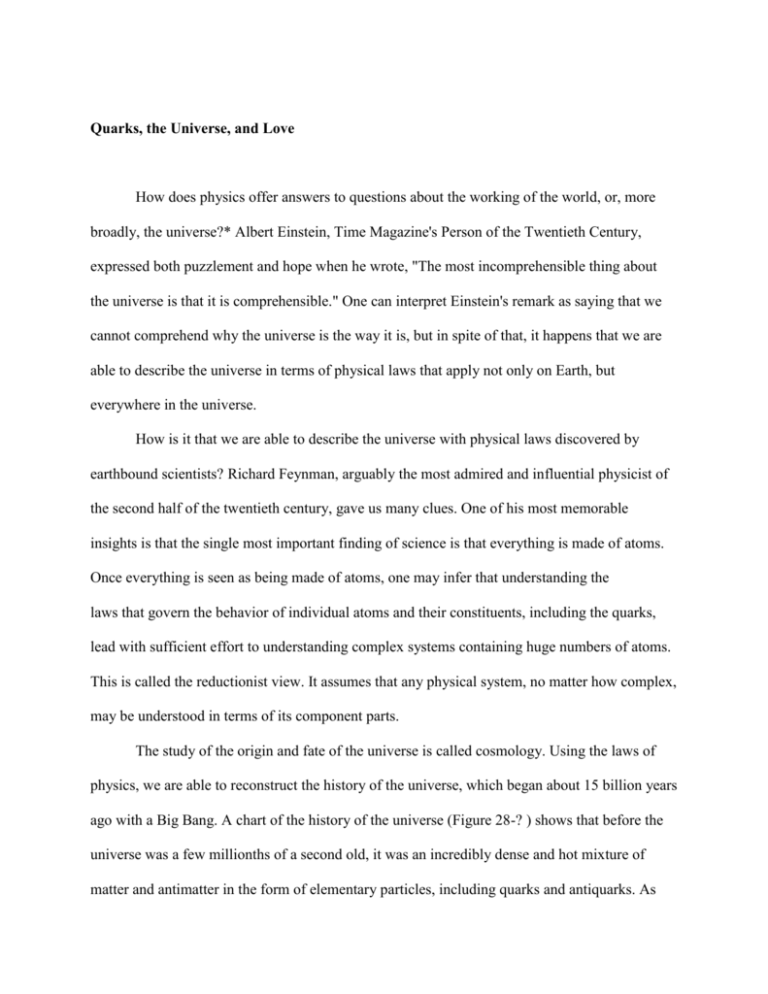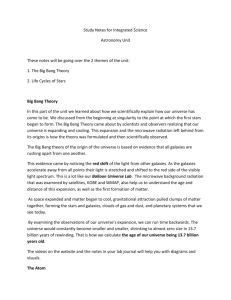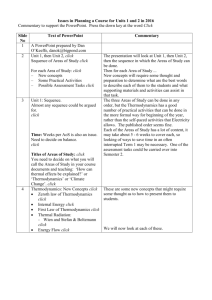Quarks, The Universe and Love
advertisement

Quarks, the Universe, and Love How does physics offer answers to questions about the working of the world, or, more broadly, the universe?* Albert Einstein, Time Magazine's Person of the Twentieth Century, expressed both puzzlement and hope when he wrote, "The most incomprehensible thing about the universe is that it is comprehensible." One can interpret Einstein's remark as saying that we cannot comprehend why the universe is the way it is, but in spite of that, it happens that we are able to describe the universe in terms of physical laws that apply not only on Earth, but everywhere in the universe. How is it that we are able to describe the universe with physical laws discovered by earthbound scientists? Richard Feynman, arguably the most admired and influential physicist of the second half of the twentieth century, gave us many clues. One of his most memorable insights is that the single most important finding of science is that everything is made of atoms. Once everything is seen as being made of atoms, one may infer that understanding the laws that govern the behavior of individual atoms and their constituents, including the quarks, lead with sufficient effort to understanding complex systems containing huge numbers of atoms. This is called the reductionist view. It assumes that any physical system, no matter how complex, may be understood in terms of its component parts. The study of the origin and fate of the universe is called cosmology. Using the laws of physics, we are able to reconstruct the history of the universe, which began about 15 billion years ago with a Big Bang. A chart of the history of the universe (Figure 28-? ) shows that before the universe was a few millionths of a second old, it was an incredibly dense and hot mixture of matter and antimatter in the form of elementary particles, including quarks and antiquarks. As time progresses, the universe expands and cools. By the time the universe is about 3 minutes old, quarks combine to form protons and neutrons, antiquarks combine to form antiprotons and antineutrons, and other quarks combine with antiquarks to form mesons. Until the universe is about 300,000 years old, protons and neutrons combine to form elements. As the cooling process continues even further, atoms are formed as electrons bind to atomic nuclei. The force of gravity plays a more dominant role as the universe approaches 1 billion years old. Gravity attracts atoms to each other forming stars and clusters of stars. Stars then become sources of energy as atoms are drawn inward by each star's enormous gravitational attraction. As atomic nuclei collide at the center of stars, they undergo nuclear fusion and release energy in the form of electromagnetic radiation that we see as sunlight. Planets are formed by smaller clusters of atoms, too few to have sufficient gravitational pull to initiate the nuclear fusion process that characterizes a star. The most amazing thing in the history of the universe, at least from our perspective, happened when one special planet, called Earth, was formed. There may be other planets like Earth that are discovered someday. What is special about Earth is that some of the atoms that collected to form Earth combined to form highly complex molecules and combinations of molecules, and enough of these complex molecules, in combination with other less complex molecules, formed what we know of as living creatures, including dogs, cats, fish of the sea, mosquitoes, alligators, and people. Remember how we got to this point. Fifteen billion years ago everything was in the form of elementary particles. The quarks that make an atom's nucleus were part of the primordial soup, as were electrons that eventually combined with the nuclear particles to make atoms. Atoms collected to form stars and planets, and then on at least one special planet, Earth, atoms really got fancy and life was formed. We finish this essay with questions, not answers. If atoms are mostly made of quarks (and electrons), and if everything is made of atoms, including people, what is it that causes very large numbers of quarks, in the form of atoms, to exhibit the complex properties of living things? The characteristic of human beings that seems most different from inanimate matter includes consciousness and the realization of emotion, including love. Perhaps the reductionist view is inappropriate and does not apply to systems as complex as living creatures. If not, why not? Whatever the ultimate answer, it will be fascinating to discover. *Essay by Robert S. Panvini, Department of Physics, Vanderbilt University.









